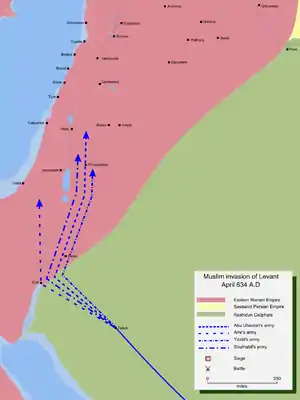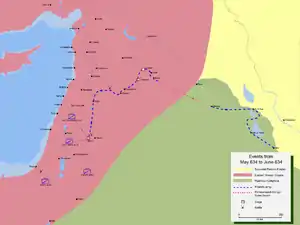634
Year 634 (DCXXXIV) was a common year starting on Saturday (link will display the full calendar) of the Julian calendar. The denomination 634 for this year has been used since the early medieval period, when the Anno Domini calendar era became the prevalent method in Europe for naming years.
| Millennium: | 1st millennium |
|---|---|
| Centuries: | |
| Decades: | |
| Years: |
| 634 by topic |
|---|
| Leaders |
|
| Categories |
|
| Gregorian calendar | 634 DCXXXIV |
| Ab urbe condita | 1387 |
| Armenian calendar | 83 ԹՎ ՁԳ |
| Assyrian calendar | 5384 |
| Balinese saka calendar | 555–556 |
| Bengali calendar | 41 |
| Berber calendar | 1584 |
| Buddhist calendar | 1178 |
| Burmese calendar | −4 |
| Byzantine calendar | 6142–6143 |
| Chinese calendar | 癸巳年 (Water Snake) 3330 or 3270 — to — 甲午年 (Wood Horse) 3331 or 3271 |
| Coptic calendar | 350–351 |
| Discordian calendar | 1800 |
| Ethiopian calendar | 626–627 |
| Hebrew calendar | 4394–4395 |
| Hindu calendars | |
| - Vikram Samvat | 690–691 |
| - Shaka Samvat | 555–556 |
| - Kali Yuga | 3734–3735 |
| Holocene calendar | 10634 |
| Iranian calendar | 12–13 |
| Islamic calendar | 12–13 |
| Japanese calendar | N/A |
| Javanese calendar | 524–525 |
| Julian calendar | 634 DCXXXIV |
| Korean calendar | 2967 |
| Minguo calendar | 1278 before ROC 民前1278年 |
| Nanakshahi calendar | −834 |
| Seleucid era | 945/946 AG |
| Thai solar calendar | 1176–1177 |
| Tibetan calendar | 阴水蛇年 (female Water-Snake) 760 or 379 or −393 — to — 阳木马年 (male Wood-Horse) 761 or 380 or −392 |

The Rashidun Caliphate invade the Levant

Events
Byzantine Empire
- Arab–Byzantine War: Emperor Heraclius, ill, infirm, and unpopular with the Eastern Orthodox Church, is unable to personally lead the Byzantine army to resist the Muslim conquest of the Levant. He sends his brother Theodore to assemble forces to retake the newly won Muslim territories. Monophysites and Jews throughout Syria welcome the Arab invaders, as they are discontented with Byzantine rule.
- July 30 – Battle of Ajnadayn: Byzantine forces (90,000 men according to Muslim sources) under Theodore are defeated by the Rashidun Caliphate near Beit Shemesh (modern-day Israel). Heraclius, who is in Emesa, flees to Antioch upon hearing news of the battle's outcome.
Europe
Britain
- Eanfrith of Bernicia and his bodyguard are killed by King Cadwallon of Gwynedd, in an attempt to negotiate peace.[1] Eanfrith's brother Oswald returns from 18 years exile in Dál Riata (modern Scotland), to claim the crown of Northumbria.
- Battle of Heavenfield: Oswald, possibly accompanied by a force of Scots (or Picts), defeats and kills Cadwallon with a Welsh army near Hexham (northern England). He reunites Deira with Bernicia, and becomes king of Northumbria.
Persia
Arabia
- Battle of Firaz: The Rashidun Arabs (15,000 men) under Khalid ibn al-Walid defeat the combined forces of the Byzantine Empire, Persian Empire and Arab Christians (at least 10 times larger than Khalid's army) in Mesopotamia (Iraq).[3]
- February 4 – Battle of Dathin: Rashidun forces under Yazid ibn Abi Sufyan defeat the Christian Arabs around Gaza. The Muslim victory is celebrated by the local Jews, who have been a persecuted minority within the Byzantine Empire.[4]
- The Rashidun Caliphate starts the Islamic conquest of the Byzantine Empire, when Muslim forces under Abu Ubaidah ibn al-Jarrah invade the Levant. Khalid sets out for Syria from Al-Hirah, taking with him half his army, about 8,000 strong.[5]
- Battle of al-Qaryatayn: The Muslim Arabs under Khalid defeat the Ghassanids at Al-Qaryatayn, after the inhabitants resist his proposals. His army conquers and plunders the city, before proceeding to capture other towns in the area.[6]
- Battle of Marj Rahit: A Muslim Arab army under Khalid defeats the Byzantine forces (15,000 men) and their Ghassanid allies. After the battle he sends a mounted column to the outskirts of Damascus, to plunder the region.[7]
- Battle of Bosra: Muslim forces under Khalid besiege the Byzantine and Christian Arab garrison (12,000 men) at Bosra. After a few days the fortress city surrenders; Khalid imposes a payment of tribute on the inhabitants.
- August 23 – Abu Bakr dies at Medina and is succeeded by Umar I, who becomes the second caliph (khalifah) of the Rashidun Caliphate. During his rule, Umar conquers Syria, Persia, and Egypt in a "Holy War".
- September 19 – Siege of Damascus: Muslim Arabs under Khalid conquer Damascus as the first major city of the Byzantine Empire. Damascan refugees are given a guarantee of safety to retreat to Antioch.
- Battle of Maraj-al-Debaj: A Byzantine convoy of Damascan refugees (10,000 men) is slaughtered by a Muslim army near Antioch. The Mobile Guard (elite light cavalry) captures a great amount of brocade.
Asia
- The Tuyuhun Kingdom is invaded by Chinese forces under Li Jing (Tang dynasty) during Emperor Taizong's campaign against Tuyuhun, resulting in the murder of their leader (khan) Murong Fuyun in 635.
- Tai Zong orders the construction of the Daming Palace in Chang'an. He builds the summer palace for his retired father, Emperor Gao Zu, as an act of filial piety.
Religion
- Aidan of Lindisfarne, Irish missionary, is summoned by King Oswald from Iona (Inner Hebrides) to establish a bishopric on the holy island of Lindisfarne, and reestablish Christianity in Northumbria (approximate date).
- Birinus, Frankish missionary, lands at the port of "Hamwic" (now in the St. Mary's area of Southampton), on his mission to reconvert the West Saxons in England.[8] About this time, the St Mary's Church is founded.[9]
- Sophronius becomes patriarch of Jerusalem. He sends synodical letters to Pope Honorius I and the Eastern patriarchs, explaining the Orthodox belief, by renouncing Monothelitism.
Births
Deaths
References
- Bede Book III, Chapter I.
- Richard Nelson Frye, The Cambridge History of Iran: The periode from the Arab invasion to the Saljuqs, p. 9. Cambridge University Press (1975)
- Akram 1969.
- Walter E. Kaegi, Byzantium and the Early Islamic Conquests. Cambridge University Press (1992)
- Akram 1970, p. 576.
- Blankinship, 1993, p. 110
- Akram 1970.
- Coles, R.J. (1981). Southampton's Historic Buildings. City of Southampton Society, p. 6
- A Brief History of St. Mary's Church. Retrieved 30 October 2009
Sources
- Akram, Agha Ibrahim The Sword of Allah:
- Akram, A. I. (1969). "The Sword of Allah: Khalid bin al-Waleed, His Life and Campaigns". Lahore: Feroze Sons. Archived from the original on February 24, 2002. Retrieved June 8, 2013.
- Akram, Agha Ibrahim (1970). The Sword of Allah: Khalid bin al-Waleed, His Life and Campaigns. Rawalpindi: National Publishing House. ISBN 978-07101-0104-4.
- Bede. "Book III". Ecclesiastical History of the English People. Internet History Sourcebooks Project.
This article is issued from Wikipedia. The text is licensed under Creative Commons - Attribution - Sharealike. Additional terms may apply for the media files.